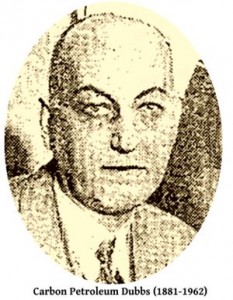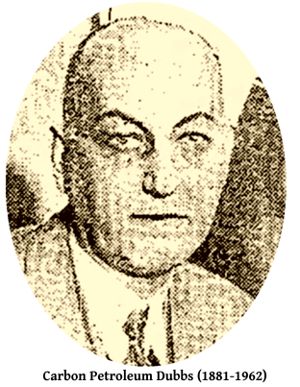 Carbon Petroleum Dubbs was born in Franklin, Pennsylvania to parents Jesse and Jennie (Chapin) Dubbs on June 24, 1881. Jesse was born in the same county (Venango) in 1856, around the time the country’s first oil was discovered, and grew up during the early boom years. It wasn’t surprising that Jesse, son of druggist Henry Dubbs, developed a fascination with the oil industry, nor that he named his son after one of oil’s elemental components. Carbon later added a “P.” to his name to make it more “euphonious”. When people began calling him “Petroleum” (perhaps people assumed that’s what the “P” stood for) the name stuck, thus he became known as “Carbon Petroleum Dubbs” (“C.P.”).
Carbon Petroleum Dubbs was born in Franklin, Pennsylvania to parents Jesse and Jennie (Chapin) Dubbs on June 24, 1881. Jesse was born in the same county (Venango) in 1856, around the time the country’s first oil was discovered, and grew up during the early boom years. It wasn’t surprising that Jesse, son of druggist Henry Dubbs, developed a fascination with the oil industry, nor that he named his son after one of oil’s elemental components. Carbon later added a “P.” to his name to make it more “euphonious”. When people began calling him “Petroleum” (perhaps people assumed that’s what the “P” stood for) the name stuck, thus he became known as “Carbon Petroleum Dubbs” (“C.P.”).
Jesse set up a “dinky” chemistry lab in a small oil field and began experimenting in an attempt to discover a way to produce gasoline from crude oil. In 1890 his neighbor, Senator Richard Quay, had him arrested for “maintaining a common nuisance” – the stench was more than the senator could bear. A trial was held a few months later and a split decision resulted – yes, he was guilty of creating a nuisance but on the second charge of continuing a nuisance he was exonerated. However, as the newspaper headline asked – “Will This Stop the Bad Odor?”1
 As an “inveterate tinkerer”2 Jesse was constantly discovering new ways to use petroleum. Like his father Henry he was a druggist by trade, inventing a protective jelly for miners, as well as inventing a process to extract sulfur from crude oil. His experiments took him far and wide around the world, despite once being kidnaped by Mexican bandits and held for a $10,000 ransom. After C.P. married Bertha Chatley in 1901 the father and son team began working on a high temperature cracking process, later to be known as the “Dubbs Process”.
As an “inveterate tinkerer”2 Jesse was constantly discovering new ways to use petroleum. Like his father Henry he was a druggist by trade, inventing a protective jelly for miners, as well as inventing a process to extract sulfur from crude oil. His experiments took him far and wide around the world, despite once being kidnaped by Mexican bandits and held for a $10,000 ransom. After C.P. married Bertha Chatley in 1901 the father and son team began working on a high temperature cracking process, later to be known as the “Dubbs Process”.
Jesse tried for years to convince investors his invention would revolutionize the oil industry. In 1909 he traveled to California “flat broke”, only to be ignored by oil company executives. One went so far as to say Jesse himself was a bit “cracked”. Yet, he continued to explore and invent – in 1909 he discovered a way to produce asphalt.
J. Ogden Armour, a hugely successful businessman at the time, invested in several companies besides his own meat packing enterprise, like the Standard Asphalt & Rubber Company. Jesse’s idea for producing asphalt would be valuable enough for his business, yet Armour also believed the oil cracking process could benefit the oil industry. Unfortunately, Jesse died in California in 1918 and C.P., a chemical engineer who graduated from the University of Western Pennsylvania and the Philadelphia College of Pharmacy and Science, took over where his father left off.
Armour purchased Jesse’s patents and made certain the process did indeed work by hiring C.P. to prove it. Armour had founded National Hydrocarbon Company, later known as Universal Oil Products, LLC (UOP), and appointed Hiram Halle to run it. One of Halle’s assignments was to keep C.P. focused on the task at hand – but, like his father, C.P. was a tinkerer. Rather than concentrate on proving his father’s patents, C.P. began experimenting with new processes. He eventually came up with a new process called clean circulation, which would prove to be even more revolutionary than the original Dubbs Process.
World War I brought huge contracts to the Armour company for its canned meats. However, when the war ended the company was left “holding the bag” with a tremendous amount of meat when wartime contracts were abruptly cancelled. For one hundred days, the company bled one million dollars a day.
Armour died broke in London in 1927 after his fortune crumbled. His creditors refused to consider the oil-cracking process stock as payments of his debts, ignoring UOP altogether – considering a handful of patents the company held of little worth, creditors took a pass. Instead, the stock passed to Mrs. Armour.
Meanwhile, C.P. continued to tinker and file patents. In 1929 he was awarded the John Scott medal for “the discovery and development of a process for producing gasoline on a large scale.”3 His (and his father’s) diligence and ingenuity, however, was set to be handsomely rewarded in 1931.
In 1930 the Armour estate closed in probate court, showing insolvency of over 1.8 million dollars – quite a plummet from a record $150,000,000 years before. Early in January 1931 Shell Union and Standard Oil of California purchased UOP and its stock for $22,249,999, making Lolita Sheldon Armour once again wealthy. Since her husband’s death, Mrs. Armour remained convinced the company her husband had originally invested over three million dollars in would somehow redeem itself.
With the sale it appeared that J. Ogden Armour’s faith and confidence in the revolutionary processes invented by the father and son Dubbs team paid off considerably. Bankers had scoffed at her for hanging on to the stock. With eight million dollars in hand she laughed right back at them.
Mrs. Armour wasn’t the only beneficiary. Carbon Petroleum Dubbs, having sold his stock in Jesse’s invention (along with the company’s sale), found himself $3,582,045 richer. Relieved that legalities were finally settled, C.P. was ready to get back to work – meaning “research and more research, perfecting the process of cracking oil.”4
The process had always been a family affair with Jesse and C.P. working side-by-side, stopping only when they were flat broke and forced to seek investors. In 1910 he had been a “wage earner” employed at an asphalt refinery. Now he was fabulously wealthy. C.P. was happy the company and its patents had been purchased by two large oil companies, saying “it is a wonderful thing for everyone involved and will be of immeasurable benefit to the oil industry as a whole.”5
He left Pittsburgh and moved to Wilmette, Illinois where he served as village president in 1933. In 1939 C.P. moved to Bermuda and built a home, although many winters were spent in Montecito, California. In 1959 he was named to the “Refining Hall of Fame”. C.P. and Bertha were the parents of three children: Jennie, Carbon Chatley and Bertha. Like his father and grandfather, Carbon Chatley Dubbs was an inventor, a chemical engineer by trade. One of his inventions was a concrete block made of pumice, later building his “dream home” entirely of concrete (including the roof).
 Did you enjoy this article? Yes? Check out Digging History Magazine. Since January 2018 new articles are published in a digital magazine (PDF) available by individual issue purchase or subscription (with three options). Most issues run between 70-85 pages, filled with articles of interest to history-lovers and genealogists — it’s all history, right? 🙂 No ads — just carefully-researched, well-written stories, complete with footnotes and sources.
Did you enjoy this article? Yes? Check out Digging History Magazine. Since January 2018 new articles are published in a digital magazine (PDF) available by individual issue purchase or subscription (with three options). Most issues run between 70-85 pages, filled with articles of interest to history-lovers and genealogists — it’s all history, right? 🙂 No ads — just carefully-researched, well-written stories, complete with footnotes and sources.
Want to know more or try out a free issue? You can download either (or both) of the January-February 2019 and March-April 2019 issues here: https://digging-history.com/free-samples/
Thanks for stopping by!

I found an old breifcase that had a return address on it with c.p.dubbs name on it .
Great article about my grandparents. Thanks
Pam, you’re welcome … thanks for stopping by!
I found an old leather breif case that had the name c.p. Dubbs on it . It was in the attic of a house we bought
He also helped install the Wilmette water plant right of Lake avenue
It may be of some interest to know that Carbon Dubbs (accidentally) introduced the cedar blight to Bermuda in the 40s when planting out his Chelston estate. This blight would decimate the beautiful endemic Bermudian cedar (Juniperus bermudiana), taking with it the primary tree of the forest canopy, permanently defacing the beauty of that idyllic island.
Even so, Chelston is still considered the finest private home in Bermuda, valued at approximately $35M USD.
My grandfather, Walter J Carey, was his driver in IL earning money as a student at Northwestern.